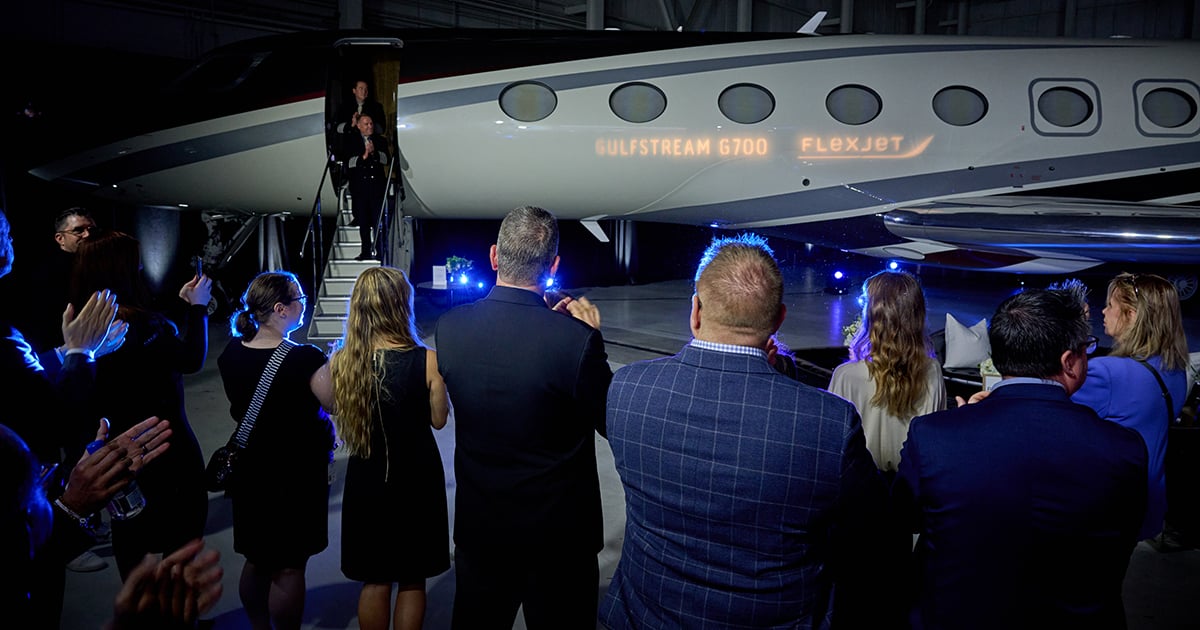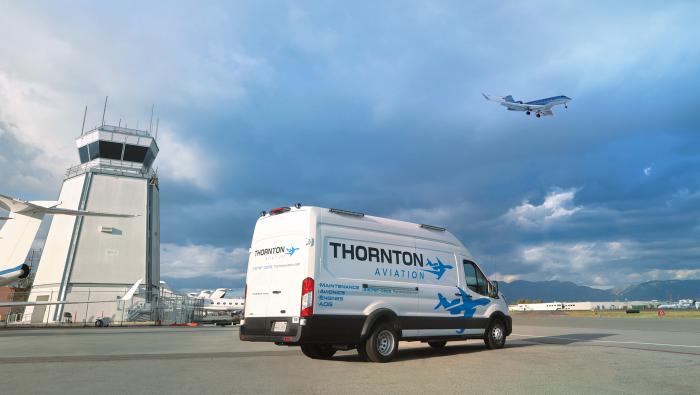|
Fractional-share operator Flexjet today unveiled the latest addition to its fleet, three $96 million Gulfstream G700s capable of flying 7,750 nm and up to 567 knots. The new members of the Flexjet fleet give customers early access to one of the hardest-to-get new ultra-long-range business jets without having to wait for years-long backlogs to clear. By the end of the year, Flexjet expects its fleet to exceed 340 jets, including more than 60 large-cabin G450s, G650s, and G700s, all fitted with Starlink low-earth-orbit satcom systems. The jets’ interiors feature Flexjet’s LXI Cabin Collection, which incorporates more than 50 custom designs, according to the company. Flexjet will operate the G700s under its Red Label program, with higher levels of comfort and service and dedicated flight crew for each aircraft. This includes dedicated cabin servers trained at Flexjet’s Red Label Academy in the UK. “True to the belief that history favors the bold, we continue to bring to market a level of luxury service and prestige that is simply not available from any other fractional provider, and the G700 is the latest example,” said Flexjet chairman Kenn Ricci. “As luxury increasingly comes to equate to the freedom and control of enriching one's time, the G700 aligns seamlessly with those who seek to shape their world both effortlessly and exceptionally.” |
|
|
The Blackhawk Group’s Performance Center in Columbia, Missouri, has achieved the first installation of Garmin’s autothrottle and Autoland system on a Beechcraft King Air 350 equipped with the G1000 NXi avionics suite. “This first installation demonstrates our readiness to deliver these industry-defining technologies to King Air 350 operators,” said Charlie Love, president of The Blackhawk Group’s Performance Center Network. “We’re excited to bring the highest levels of automation and safety ever available in this platform directly to our customers.” Garmin’s G1000 NXi integrated flight deck is required for the Autoland system in King Airs, along with the autothrottles. The system will automatically select a suitable airport and communicate with ATC and on local airport frequencies while configuring the airplane to land, touching down, applying brakes, and shutting off the engines. Autoland is only available for emergency situations and will activate if it detects an unresponsive pilot; alternatively, anyone on board can activate the system with the push of a button. The autothrottles manage speed and power from takeoff to touchdown, protecting against engine exceedances. Additional assistance is available via automatic autothrottle engagement during under- and overspeed scenarios or engine-out situations. |
|
|
Roger Woolsey, owner and CEO of Million Air Interlink (the parent company of the Million Air FBO chain) and REW Investments, has been named the 2025 recipient of the National Air Transportation Association’s (NATA) highest honor, the William A. “Bill” Ong Memorial Award. A seasoned aviator with more than 26,000 flight hours, Woolsey has earned an airline transport pilot certificate, multiple type ratings, and an airframe and powerplant mechanic certificate during his career that spans nearly four decades. Starting at age 19, he became the youngest FAA air carrier operator in history, and went on to launch several successful businesses, including Prestige Touring and American Jet International. Woolsey joined the FBO industry in 2002 when he acquired Million Air Interlink and has since grown it into one of the most recognized brands in the industry with nearly 40 company-owned and franchised locations in North America, including in Hawaii. “Aviation has been a lifelong passion for me,” explained Woolsey, adding that his father was a pilot, which spurred a fascination with flying from a young age. “I’m an aviator at heart, and while I never set out to be where I am today, I’ve always carried a bigger vision for what this industry could be.” The award will be presented to Woolsey in November at NATA’s annual Aviation Business Conference, to be held this year in Dallas. |
|
|
Business jet inventories are stabilizing in September, according to Jefferies, holding steady even as manufacturer-level trends diverged. The firm reported 1,211 used business jets for sale, equaling 4.8% of the active fleet across all vintages. The figure was flat compared with August, down 3% year over year (YOY), and up 6% over the past six months. For aircraft less than 7 years out of production, inventory was unchanged YOY and declined 4% month over month, equal to 3.5% of that fleet segment. Light-jet availability fell 10% from a year ago, while heavy jets rose 2% and midsize jets were flat. Jefferies said stabilization in newer-model inventory was reflected in pricing, which was flat YOY but increased 4% sequentially. Over the trailing six months, pricing was down 6%, and over the trailing 12 months, down 7%. By manufacturer, results varied. Bombardier units for sale declined 10% YOY to 55 aircraft, representing 3.0% of its fleet. Globals were down 13%, while Challengers and Learjets held flat. Cessna listings fell 5% to 75 units, equal to 3.4% of its fleet. The decline included three fewer CJ3+ aircraft, along with reductions in the CJ4, Citation X+, and XLS+. Jefferies said the combination of flat month-over-month supply and modest sequential pricing gains in September points to stabilization after several months of rising inventory. |
|
|
Sponsor Content: Thornton Aviation Building trust, fostering teamwork and delivering exceptional outcomes. Thornton Aviation’s success is the result of more than technical expertise. |
|
|
Honeywell Aerospace has appointed UK-based MRO provider Zenith Aviation as a Channel Partner for supporting the OEM’s TFE731 engines and auxiliary power units under its Maintenance Service Plan. Zenith said investment in equipment and capabilities from its new owner, aircraft charter and management group Opul Jets, facilitated the new designation. TFE731 turbofans power multiple business jets, including various Bombardier Learjets, Cessna Citations, and Dassault Falcons. Zenith’s own fleet includes a Learjet 45 and 75, and the company—based at London Biggin Hill Airport (EGKB)—also supports aircraft operated by Opul. As part of plans to boost the scope of its MRO business, Zenith also appointed Gary Tims as director of maintenance. He is a Form 4 Post Holder approved by the UK CAA, with multiple years of business aviation experience with companies including Jetworks, H+S Aviation, and Harrods Aviation. Zenith is looking to expand its MRO customer base in Europe and the Middle East. “With Opul’s backing, we have made the investment required to expand our capability and secure the [Honeywell] business for the long term,” said company COO Aaron Hughes. “It has the potential to unlock millions in additional revenue while delivering better service and greater certainty for our customers and staff.” |
|
|
A new FAA Safety Alert for Operators (SAFO 25002) highlights the continuing fire risks associated with the carriage of lithium batteries—and the devices that operate off them—in aircraft passenger and crew compartments. In addition, the alert emphasizes the importance of identifying all potential hazards and implementing risk mitigation strategies to manage thermal runaway events, which are self-sustaining, uncontrolled increases in pressure and temperature. Recent FAA data shows a number of safety events involving lithium batteries. “Lithium batteries stored in passenger overhead bins and/or in carry-on baggage may be obscured, difficult to access, or not readily monitored by passengers or crew members,” notes the alert. “Because of this, detection of thermal runaway and firefighting measures may be delayed in flight, increasing the risk to safety.” The FAA warns that traditional firefighting methods may not work. “Use of Halon extinguishers can briefly suppress open flames; however, they do not halt the thermal runaway process. The primary response involves using large amounts of water to cool the battery and suppress flames. Cooling the device with water is essential to prevent the reaction from continuing until all cells have discharged their energy.” Since lithium batteries have become common power sources in personal devices, the FAA, EASA, and other authorities have issued a number of advisories to emphasize the risks and mitigation measures. |
|
|
Duncan Aviation has added a full-service battery shop to its satellite repair facility at Scottsdale Airport (KSDL) in Arizona. With the ability to provide main-ship and emergency battery maintenance services on units from top manufacturers including Aero Design, Concorde, Saft, Marathon, Securaplane, and L3 Harris, the location has separate rooms for testing and working on different battery types including absorbed glass-mat, Nickel-cadmium, and NZ batteries such as those contained in the Honeywell NZ-2000 and IAC-600/800 Nav and IAC computers. Among the services offered are battery replacements and restorations, 100-hour inspections, deep cycle and capacity checks, battery re-blocks and bench tests, and new unit sales. “We are very excited to respond to the many customer requests we have received to add battery maintenance to our services available through our Scottsdale satellite,” Matt Nelson, Duncan’s enterprise satellite manager, told AIN. “This is a new addition to Scottsdale, joining those in Bedford, Massachusetts; Atlanta, Georgia; St. Paul, Minnesota; Kansas City, Missouri; and Seattle, Washington.” |
|
|
AMAC Aerospace has reported a flurry of maintenance, repair, and overhaul (MRO) activity in the corporate and VIP markets. In recent months, the Switzerland-based group’s engineering teams have conducted extensive work on various large-cabin jets. At the company’s headquarters in Basel, Switzerland, it recently completed 12-year inspections on a pair of Airbus ACJ319s. Work on the two Singapore-based aircraft included installation of an upgrade to the in-flight entertainment systems, refurbishment of the divans and carpet, as well as a new exterior paint job. AMAC has also conducted a 72-month inspection on a Gulfstream IV based in the Asia-Pacific region. Its Swiss division recently delivered three aircraft back to operators in Asia, which included another ACJ, a Boeing Business Jet, and a G450 from South Korea. In the first week of September, the facility handled multiple scheduled inspections on a Bombardier Challenger 605. The company’s facility at Bodrum in Turkey splits its MRO capacity between work on VIP and business aircraft during the summer months and commercial airliner support in the winter. It recently completed a 12-year inspection for a Boeing Business Jet in a project that included the installation of an all-new cabin interior and the addition of an auxiliary fuel tank in the center section of the fuselage. |
|
|
Rolls-Royce has retired its Boeing 747-200 flying testbed (registered N787RR), a uniquely modified aircraft instrumental in the OEM’s engine development and evaluation. However, with the so-called “Queen of the Skies” withdrawn from service, Rolls-Royce will continue its testing endeavors with a combination of flying assets, ground testing, and digital modeling. For the last two decades, the “Flying Test Bed” has proven a key airborne asset with its ability to operate an additional fifth powerplant, installed on a bespoke wing-mounted pylon. Its achievements included the 2021 testing of a 100% SAF-powered Trent 1000 (preceding Virgin Atlantic’s 100% SAF-powered transatlantic flight) and the Pearl 10X, optimized for the upcoming Dassault Falcon 10X. Other programs included testing and validating the Advance and UltraFan technology. N787RR’s final mission, completed in July 2025, supported Rolls-Royce’s Advanced Low Emissions Combustion System (ALECSys). In total, the aircraft facilitated more than 2,000 hours of testing. Rolls-Royce director of test and experimental engineering John Knight described the flying testbed as a “workhorse” and one which helped “push the boundaries of engine development.” However, amid rising costs of running a 45-year-old airframe, the former Cathay Pacific airliner has now reached the end of its testing tenure. Rolls-Royce has not publicly stated a successor, although previous plans to convert a younger 747-400 were shelved in 2022. |
|
|
|
|
|
|
AINalerts News Tips/Feedback: News tips may be sent anonymously, but feedback must include name and contact info (we will withhold name on request). We reserve the right to edit correspondence for length, clarity, and grammar. Send feedback or news tips to AINalerts editor Chad Trautvetter. |
|
AINalerts is a publication of AIN Media Group, 214 Franklin Avenue, Midland Park, New Jersey. Copyright 2025. All rights reserved. Reproduction in whole or in part without permission is strictly prohibited. |

















